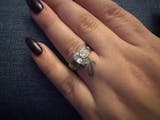Opals are a beautiful choice for engagement rings, with their natural colors that shift and change in the light. Each opal shows different combinations of blue, red, and green, making it special and unique. While diamonds are traditional, opals offer something different - they're precious stones with deep cultural meaning as symbols of hope and devotion. An opal engagement ring stands out with its natural beauty and personal character, perfect for couples who want a ring that feels uniquely their own.

The Unique Characteristics of Opals
How Opals Form in Nature
Opals develop in rock cavities where silica-rich water collects and hardens over millions of years. As the water evaporates, it leaves behind tiny spheres of silica that stack in orderly patterns. These spheres, each about 150 to 300 nanometers wide, create the opal's structure. When light hits these stacked spheres, it breaks into the rainbow colors we see in the stone.
The conditions must be perfect for opals to form. The rock must have the right amount of porosity, the water must contain enough dissolved silica, and the temperature needs to stay steady. These specific requirements explain why high-quality opals are rare and valuable.
Types of Opals and Where They Come From
Black Opals
Black opals from Lightning Ridge, Australia, are the most valuable type. Their dark background makes their colors appear more vivid against the black base. The best specimens show bright patterns of blue and green, with occasional flashes of red and orange.
White Opals
White or light opals come from South Australia's Coober Pedy region. These stones have a lighter background, which gives them a softer, more subtle appearance. Their colors often include pastel blues and greens.
Boulder Opals
Queensland, Australia produces boulder opals, which form in ironstone rock. These opals stay attached to their brown ironstone base, creating natural patterns that make each stone unique. The contrast between the dark iron and bright opal creates striking patterns.
Fire Opals
Mexico's mines yield fire opals, known for their warm orange to red body color. Unlike other opals, fire opals may or may not show the typical color play. The best specimens combine their rich body color with flashes of green or blue, though many prized fire opals are valued simply for their clear, intense orange color.

Opal Engagement Rings: Meanings Through Time and Culture
Historical Beliefs: From Rome to Ancient Greece
Ancient Romans treasured opals as symbols of good fortune and love. They called opals the "Queen of Gems" because each stone contained the colors of all other precious stones. In Ancient Greece, people believed opals gave their owners the gift of prophecy and protected them from illness.
Middle Eastern legends told that opals fell from the sky in flashes of lightning, leaving behind stones filled with captured rainbow colors. Australian Aboriginal stories connected opals to the creation time when a giant rainbow touched the earth and turned the rocks into these colorful gems.
Traditional Meanings: Protection, Truth, and Divine Light
Arabic cultures saw opals as symbols of hope and purity, believing the stones fell as rays of divine light. In medieval Europe, blonde women wore opal jewelry to protect their hair's light color. The stones also gained fame as symbols of truth and faithfulness in several European royal courts.
Modern Engagement Symbolism: Creativity and Individual Expression
Today, opals represent individuality and artistic expression in engagement rings. Their ever-changing colors mirror the depth and variety of love in relationships. Many couples choose opals because each stone tells its own story through its unique pattern of colors.
The growing popularity of opal engagement rings connects to modern values of personal expression and breaking from tradition. Young couples often select opals to represent their creative spirit and willingness to make their own traditions.
Modern Meanings: Personal Choice and Unique Beauty
Opals hold special meaning for couples who value creativity and uniqueness in their relationship. Some choose opals because their birthdays fall in October, when opal serves as the month's birthstone. Others select these gems because they share significant moments in places where opals are found, like Australia or Mexico.
Opal Engagement Rings: Design Elements and Settings
Setting Styles: Types and Features
Bezel Settings
The bezel setting wraps a metal rim completely around the opal's edge, offering the best protection for these delicate stones. This secure setting prevents the opal from chipping and keeps water from reaching the stone's base. The clean lines of a bezel setting also create a modern, sophisticated look.
Prong Settings
Prong settings lift the opal above the band with small metal claws, allowing more light to reach the stone. While this setting shows off more of the opal's surface and color play, it provides less protection. Most jewelers recommend four to six prongs to properly secure the stone.
Halo Settings
Halo settings surround the opal with small diamonds or other gemstones. This style not only protects the opal's edges but also makes the center stone appear larger. The surrounding stones add sparkle while highlighting the opal's natural colors.
Half-Bezel Settings
Half-bezel settings cover only part of the opal's edges, offering a balance between protection and light exposure. This modern variation shows more of the stone while still providing good security, making it popular for contemporary designs.
Metal Options: Colors and Durability
White Gold: Clean and Modern
White gold creates a neutral backdrop that lets the opal's colors shine. Its bright white color works especially well with light opals and diamond halos. The rhodium plating on white gold also adds durability to the ring's surface.
Yellow Gold: Traditional Warmth
Yellow gold brings warmth to an opal ring and pairs beautifully with fire opals and stones showing orange or red colors. Traditional 14k or 18k gold provides good durability while maintaining a rich color that doesn't overshadow the opal.
Rose Gold: Romantic Touch
Rose gold's pink hue offers a romantic look that complements the soft colors in white opals. This metal choice adds a unique touch to classic settings and works well in vintage-inspired designs.

Platinum: Premium Protection
Platinum's natural white color and superior strength make it ideal for protecting opals. Though more expensive, platinum won't change color over time and resists scratching better than gold. Its weight also provides extra security for delicate stones.
Opal Engagement Rings: Guide to Smart Buying
A quality opal engagement ring combines several important features. Each of these affects the stone's beauty and value.
Color Quality and Vibrancy
Quality opals show bright colors that change with movement. Red is the most valuable color, followed by orange, green, and blue. Good opals keep their colors in different types of light. The colors should remain clear when viewing the stone from different angles.
Stone Durability and Structure
Black opals cost more because their dark background makes colors stand out better. Light or white opals should have a clean, clear base without dark spots. Crystal opals need to be clear throughout, with no cloudy areas.
Pattern Distinctiveness
Good opals have clear color patterns. Some show broad areas of single colors, while others display tiny dots of color throughout. The rare harlequin pattern looks like small colored squares. Rolling flash patterns show colors that move across the stone's surface.
Physical Condition
A good opal has a smooth surface without scratches or chips. The stone should have an even, rounded top without flat spots. The surface needs to be well-polished without rough areas. Avoid stones with cracks or stress lines inside, as these can break easily.
Size and Shape Impact
Larger opals generally cost more than smaller ones. Regular shapes like ovals and rounds are usually less expensive than custom cuts. The best designs match the opal's natural pattern with its shape and setting.
Price and Value Considerations
The opal market has options for different budgets. Some buyers choose doublet or triplet opals, which look similar but cost less. Getting certification from a gemology lab helps protect your purchase. Look for stones with proper documentation that match your budget and style preferences.
Find Your Opal Engagement Ring!
An opal engagement ring offers both beauty and personal meaning. These gems come in many colors and styles, from bold black opals to soft white stones. With attention to quality, setting, and proper certification, you can select a ring that stays beautiful for years to come. Whether you choose a classic or modern design, an opal ring makes a special choice that stands out from traditional engagement rings.












